Exploring the Badlands of North Dakota at Theodore Roosevelt National Park!
We had not heard much about Theodore Roosevelt National Park in North Dakota before we found ourselves up in that area following the FMCA Rally in Minot ND. When we mapped out that portion of our trip, we realized that heading from the rally toward Yellowstone National Park would take us right past Theodore Roosevelt National Park. We did a bit of research and found that they had two RV/tent campgrounds in the park, so we decided to visit for a few days to break up our trip to Wyoming. Wow! What an incredible find! Four nights here just were not enough. We enjoyed hiking and exploring, and found a lot of wildlife. The unique geography of the area (part of the North Dakota Badlands) also fascinated us. And that's just the beginning.
Camping at Theodore Roosevelt National Park
There are two campgrounds within Theodore Roosevelt National Park. Both campgrounds are open to tent campers and RVs. And both are open year round. Fees are also collected year round, but change with the seasons since services are limited between mid-October and mid-May.
We stayed 2 nights in each campground during our stop here in August. All sites are dry camping, with fresh water available seasonally in the campgrounds to fill your RV's fresh water tank. Park hosts were on duty at each campground during our visit.
The maximum stay is 14 days.
Generator hours are 8am until 8pm. Quiet hours are 10pm to 6am.
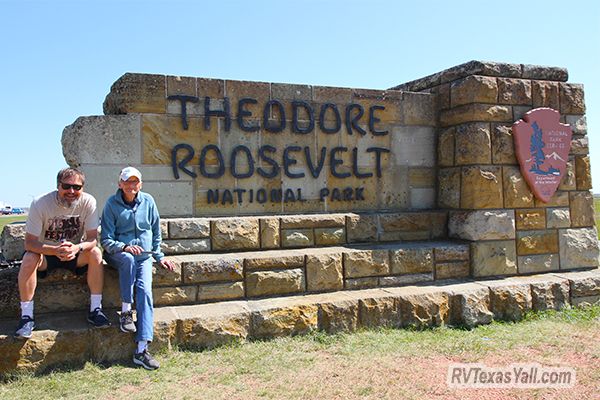
Theodore Roosevelt National Park Sign
Juniper Campground
Located in the North Unit of Theodore Roosevelt National Park near Grassy Butte ND, the Juniper Campground is made up of 48 individual dry camping sites and a group camping area. The standard campsites are first come, first served. Reservations are required for the group camping area (which is only open May through September).
From mid-May until mid-October, the Juniper Campground offers a restroom with sinks and flush toilets, potable water stations, camp hosts and a dump station. Vault toilets are available in the off-season. There are no showers, no laundry, no camp store and no firewood or ice for sale.
Cell service and internet are extremely limited to non-existent.
The North Unit's amphitheater is located next to the Juniper Campground. It operates seasonally.
Some of the sites are pull-through (approximately 28), others were back-in (11), and 9 are walk-in tent sites. The park has recently lost a few campsites to erosion at the river. Trees and tight turns will make this a challenging campground for rigs larger than 35' long. A few of the pull-thru sites are large enough for larger RVs, but we'd suggest arriving early for best selection. Back-in sites max out at about 20 feet.
Our campsite included a picnic table and BBQ pit. Sites are a mix of sun and shade. Check-in is via an iron ranger self-registration station at the entrance to the camping loop.
Trash and recycling bins are located throughout the camping loop.
During our stay in August, the camping fee was $14 per night or $7 with the Senior or Access Pass. Winter rates run 50% of the Summer rates. Separate park entrance fees are also required unless you have a current National Parks Pass.
See a Map of the Juniper Campground.
Cottonwood Camground
Near the town of Medora ND in the South Unit of Theodore Roosevelt National Park, the Cottonwood Campground is the only campground in the southern section of the park. It features 37 Reservable Campsites (May through September) and 36 First Come, First Served Campsites. Peak Season reservable sites can be reserved up to six months in advance. All campsites are first-come, 1st served from October through April. A group site is also reservable 12 months in advance.
From May until October, the Cottonwood Campground features camp hosts, potable water stations, and restrooms with sinks and flush toilets. Vault toilets are available year round. There are no showers, no laundry, no dump station, no camp store and no ice or firewood sales.
The Cottonwood Campground is not as remote as the Juniper Campground, but cell service and internet connectivity is still limited.
The Cottonwood Campground is made up of two loops. The North Loop has 16 pull-thru sites, 6 parallel sites (that sit on the side of the road), and 9 back-in sites. The South Loop has 20 back-in sites, 2 parallel sites, and 12 walk-in tent sites.
The back-in sites in the South Loop max out at 25 feet. Some of the pull-through and parallel sites are able to hold large rigs, but tight turns and trees can make driving through the campground challenging.
Our campsite featured a picnic table and fire ring. Sites are a mix of sun and shade. Check-in is via the registration station at the campground entrance.
Trash and recycling bins as well as potable water stations are available throughout the campground.
Camping fees in the Cottonwood Campground are the same as the Juniper Campground, including half price for folks with a Senior or Access Pass and in the off-season.
See a Map of the Cottonwood Campground.
Reserve a Campsite in the Cottonwood Campground
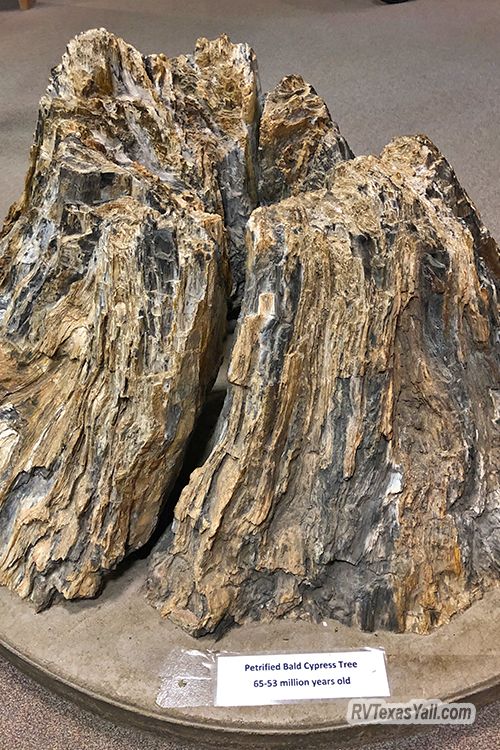
Petrified Wood
Theodore Roosevelt National Park Geology
We were amazed by the geologic variety here. Years of buckling land masses, ash from distant volcanoes, wind erosion, shifting rivers and giant ice sheets have created an amazingly unique landform here at Theodore Roosevelt National Park. Here are some of our favorite features:
Cannon Ball Concretions
Maybe the strangest, most unexpected rock formations we've ever seen, the cannon ball concretions are found on the main park road of the North Unit immediately across from the road that leads to the Juniper Campground. These fascinating cannon ball shaped formations were shaped when outer soft layers eroded to reveal the much harder mineral core which happens to be round! They expect more concretions to appear as the rocks continue to erode.
Fossils
Millions of years ago, the environment here was similar to the swampy areas of Florida. Fossilized remains of several crocodile-type creatures, alligators, turtles, and mollusks have all been discovered in the park.
Petrified Wood
Another nod back to this area's time as a subtropical region, you'll find the 3rd largest petrified wood forest in the US in the park's South Unit. You can hike the Petrified Forest Trail which is located in the South Unit about a 30 minute drive from Medora on gravel roads. If hiking isn't your thing, or you don't have the time to drive out to the forest, you can see a large piece of petrified wood inside the park's South Unit Visitor Center.
Coal Beds
It is said that Teddy Roosevelt shoveled coal to heat his home from the coal that occurs naturally here. A 12-foot thick coal vein buried deep in the ground caught fire here in 1951. It burned for 26 years! You can see how it changed the landscape on the Coal Vein Trail.
Glacial Erratics
Today, there are no glaciers in Theodore Roosevelt National Park. But the North Unit was once on the edge of a huge glacier field. As the ice shifted, it carried huge granite rocks to new locations far from their original home. Today you can see some of these granite boulders that are unlike any other rocks in the park in the North Unit where they were deposited by the glaciers so many years ago.
Slumpblocks
Mind-boggling is the best way we can describe slumping. It's when a large section of rock separates from the landmass and slides down very slowly. What?!? If you stop and look at the rock sides, you'll see a lot of slumpblocks around the park. Look for the patterns that don't quite match up.
Animals at Theodore Roosevelt National Park
Another reason why we love this park, Theodore Roosevelt National Park is home to TONS of wildlife! During our stay we watched bison, prairie dogs, wild horses, turkeys, deer, red fox and pronghorn. The prairie dog towns here are HUGE, by the way!
Theodore Roosevelt National Park is also home to elk, longhorn steers, rabbits, golden eagles, great horned owls, badgers, and over 186 species of birds. Amphibians and reptiles exist in the park, but are said to be uncommon due to the extreme weather and semi-arid climate.
Plant Life at Theodore Roosevelt National Park
Theodore Roosevelt National Park features rocky badlands, grasslands and forests. Both of the park campgrounds are covered in trees providing great shade in the Summer. It is said that there may be 500 different plant species living inside the park. Spring and Summer are a great time to see huge fields of wildflowers.
Rocky Mountain Junipers are the dominant tree here. You'll also find a few hardy hardwoods that survive in the dry climate by sticking closer to riverbanks: cottonwoods, box elders and specific types of elm and ash trees.
As you might expect from an ecosystem that houses large numbers of grazing animals, there are thousands of acres of grasslands within the park. A few of the grass species here include bluestem, wheatgrass and saltgrass.
History of Theodore Roosevelt National Park
Perhaps because of it's challenging landforms and climate, human habitation of the park area seems limited to within the past 2,000 years of so. Most of the artifacts that have been discovered point to the land being used primarily as a hunting, trapping, gathering and spiritual place.
Theodore Roosevelt Slept Here
New York Native, Theodore Roosevelt, came here first in 1883. He came to hunt bison and experience the life of the West that he had long dreamed about. Though bison hunting was difficult because most of the herds had been wiped out by commercial hunting before his arrival, Roosevelt discovered an interest in cattle ranching.
In the 1880s, large herds of cattle were arriving from Texas to feed on the vast acres of grasslands, and Frenchman the Marquis de Mores was building the town of Medora as a center for beef processing. Before his return East, Roosevelt invested $14,000 to build his Maltese Cross Cabin as his Dakota home and center of his new cattle ranching operation.
Shortly after his return East, Theodore Roosevelt received word that both his mother and wife were gravely ill. Both women passed away on February 14, 1884 in the same house, and after he completed that year's spring legislative session, Roosevelt returned to North Dakota to escape his grief.
His Maltese Cross Cabin had been built about 7 miles south of Medora, on a major route leading to town. Seeking to be more remote, Roosevelt established his Elkhorn Ranch 35 miles north of Medora. He spent the next few years going back and forth between his political life in New York and his ranching life in North Dakota.
But the region's cattle ranching prosperity of the 1880s was short-lived. Overgrazing and temperatures reaching -41 over the winter of 1886-1887, followed by floods as the snow and ice melted, wiped out half of Roosevelt's herd. He began to exit the cattle business, which he now saw as unsustainable, and had sold all of his Dakota interests before 1900.
Though Theodore Roosevelt's actual time in the North Dakota Badlands was limited, it is said to have shaped the rest of his life. He later formed the Rough Riders calvary unit who earned greatness for their role in the Spanish-American War. He became the youngest President in US history in 1901 when President William McKinley was assassinated. He served as President until 1909. He is known today for his strong stands on land and wildlife conservation, and for playing a large role in the development of our National Parks system. During his Presidency, Theodore Roosevelt set aside almost one-tenth of the land in the United States (230 Million acres) as National Park, National Forest and National Monument land, earning him the title of "Conservation President".
The Only National Park Named For a Person
Theodore Roosevelt passed away in 1919. Soon afterward, talks began about naming a park in his honor. It was fitting that his old stomping grounds would form the park, but actual creation of the park would take decades.
The Roosevelt Memorial National Park Association was formed in 1924 with a plan for developing a 2,030 square mile park. Over the years, suggestions were made for the area to become a National Monument or a National Forest.
The Civilian Conservation Corps (CCC) arrived here in 1934 to build a state park. The North and South Units had their own camps, each of which built campgrounds, buildings, trails, picnic areas and roads. They were assisted by workers from the Works Project Administration (WPA) and Emergency Relief Administration (ERA). Work ended in 1941 as the US entered World War II, but the park was still without a management plan. Would it be a state park? A National Forest Park? A National Monument?
The land became the Theodore Roosevelt National Wildlife Refuge in 1946, and was named Theodore Roosevelt National Memorial Park in 1947 by President Harry S Truman. It was the only Memorial Park in the National Park system. At this point, the park included the South Unit and the Elkhorn Ranch site. The park expanded to include the North Unit in 1948.
President Jimmy Carter officially named the park Theodore Roosevelt National Park in 1978. Today's park is made up of 70,448 acres and allows folks to experience the land in much the same way as Theodore Roosevelt would have in the 1880s.
Theodore Roosevelt National Park Location
Theodore Roosevelt National Park is located in western North Dakota off of Interstate 94 and Highway 85. It is approximately 465 miles northeast of Yellowstone National Park and 260 miles north of Mount Rushmore National Monument. It is located within the Little Missouri National Grassland which is the largest grassland in the USA. It has 2 major units: North and South which are approximately 75 miles apart. Each unit offers a unique experience. We definitely recommend spending time in both.
Theodore Roosevelt National Park North Unit
The North Unit of Theodore Roosevelt National Park is located off of Highway 85 between Watford City and Grassy Butte, North Dakota. This is the lesser visited section of the park, but has features you won't see in the South Unit (like the cannon ball concretions and CCC overlook). It is definitely worthy of a visit. The North Unit is more remote than the South Unit, but still has a small ranger station. Make sure you have your provisions before you arrive as stores and fuel are a little ways from the park.
Theodore Roosevelt National Park South Unit
Closer to civilization, the South Unit of Theodore Roosevelt National Park is much more popular than the North Unit. It is located on Interstate 94 and the entrance to the park sits on the edge of downtown Medora, North Dakota. Here you'll find star gazing programs and wind eroded canyonland as well as a larger visitor center with Roosevelt's Maltese Cross Cabin.
Other Sections of Theodore Roosevelt National Park
Painted Canyon
Home of another park visitor center, restrooms and an amazing scenic overlook, you'll find the Painted Canyon on Interstate 94 between the South Unit and Highway 85. There is plenty of RV parking, so stop and get your National Parks Passport Stamp! You can also access the Painted Canyon Nature Trail here or take advantage of the picnic tables. Be sure to bring your binoculars!
Elkhorn Ranch
The homesite of Theodore Roosevelt's second (and more remote) ranch home. This site originally included his home, a dugout, a blacksmith shop and a barn amongst other buildings. Today, all that remains is the foundation, but it could still be an interesting place to visit and reflect on what life would have been like here in the late 19th century. Elkhorn Ranch is accessible via dirt roads, so check with the South Unit Visitor Center regarding accessibility during your visit.
Hiking at Theodore Roosevelt National Park
As with many National Parks, there are a wide variety of hiking options in Theodore Roosevelt National Park. Trails here range from flat, paved 10 minute walks to extremely challenging 10-12 hour hikes. Serious hikers can also connect to National Grassland trails. Below is a list of some of the trails in the park along with their difficulty rating according to the park:
Theodore Roosevelt North Unit Hiking Trails:
Little Mo Trail (easy)
Caprock Coulee Nature Trail (moderate)
Sperati Trail (moderate)
Buckhorn Trail (moderate - strenuous)
Achenbach Trail (moderate - strenuous)
Caprock Coulee Trail (strenuous)
Theodore Roosevelt South Unit Hiking Trails:
Skyline Vista (easy)
Boicourt Overlook Trail (easy)
Buck Hill (easy)
Wind Canyon Trail (easy)
Ridgeline Trail (moderate)
Coal Vein Trail (moderate)
Painted Canyon Nature Trail (moderate)
Lower Paddock Creek Trail (moderate)
Upper Paddock Creek Trail (moderate)
Jones Creek Trail (moderate)
Lower Talkington Trail (moderate)
Upper Talkington Trail (moderate)
Maah Daah Hey Trail (strenuous)
Lone Tree Loop (strenuous)
Petrified Forest Loop (strenuous)
The Maah Daah Hey Trail connects the North and South Units with a length of 96 miles.
Accessible Hiking in Theodore Roosevelt National Park
The following trails are marked as accessible by the park:
North Unit: River Bend Overlook, Oxbow Overlook, part of Little Mo Nature Trail
South Unit: Painted Canyon Overlook, Buck Hill, Skyline Vista, Boicourt Trail
Some of the trailheads offer Guides so you'll know what to look for. We first discovered these informative guides at the Coal Vein Trail.
Things to See and Do at Theodore Roosevelt National Park
There are a lot of great options of things to do and see when you're visiting Theodore Roosevelt National Park!
Visitor Centers
There are three Visitor Centers at Theodore Roosevelt National Park: North Unit, South Unit and Painted Canyon. The North Unit visitor center is the smallest, but still offers a movie about the park and rangers to answer questions. The South Unit Visitor Center provides the most information about the park including exhibits about the natural and human history of the area. It is also home to the Maltese Cross Cabin. All three Visitor Centers have unique stamps for your National Parks Passport book.
Roosevelt's Maltese Cross Cabin
Teddy Roosevelt's original cabin from 1884 now sits behind the South Unit Visitor Center. The guided Ranger Program explains the history of the cabin and its many travels. (Yes, this cabin has its own travel history!)
Ranger Programs
Both the North and South Units host active Ranger Programs from May through September. Be sure to check out the schedule during your visit. We learn a ton about the parks from the Ranger programs!
Scenic Drives
Both the North and South Units of Theodore Roosevelt National Park include scenic drives. Both are a great way to see the park.
North Unit 14 Mile Scenic Drive: An out and back drive that begins in the canyon and works its way up to the stunning River Bend Overlook before ending at the Oxbow Overlook. While the park says that this drive is open to RVs, take note that there is a short section of gravel road and a few switchback-style turns as the road moves out of the canyon. This is also an out and back drive, not a loop, and large vehicle turn around options are limited. Make sure you take time to stop and see the River Bend Overlook. It's one of our favorite places in the park.
South Unit 36 Mile Scenic Loop: So actually, due to a landslide, the scenic loop in the South Unit has changed. During our visit, the section between Ridgeline Trail and Peaceful Valley Ranch was closed to motorized vehicles. That makes this a 24 Mile One Way (48 miles out and back) drive. Since it is an out and back drive, we wouldn't suggest taking your RV on the drive until they reopen the entire loop. There are very limited areas where you might be able to turn around. Be sure to check out Wind Canyon and the Coal Vein area.
Star Gazing
We could never explain to you how many stars are visible here! To say it's a blanket of stars would be a massive understatement. There were so many stars in the sky at night that we couldn't pick out even basic constellations (like the Big Dipper)! If you're there during a time when John and Brenda of Geo Astro are hosting sky parties, make sure you get over to Peaceful Valley Ranch in the South Unit to participate. Fascinating! The annual Dakota Nights Astronomy Festival is also held here.
Visit Medora, North Dakota
Our pick for Top Tourist Town of 2019, the tiny town of Medora, North Dakota oozes charm. With its roots back to the day when Theodore Roosevelt was pursuing his ranching dream, today Medora relies on visitors to the National Park who want to expand their experiences beyond the park boundaries. You'll find shops, restaurants, hotels, an RV park, a state historic site, and quite a number of live plays and musicals in town during the tourist season of May through September. This is an easily walked town located at the entrance to the South Unit of Theodore Roosevelt National Park.
Tips for Visiting Theodore Roosevelt National Park
Know Your Time Zones! Theodore Roosevelt National Park operates on two time zones. The North Unit is on Central Time and the South Unit is on Mountain Time (one hour behind). Make sure you pay attention to the time zones when you are planning your trip.
Rules for Pet Owners: Pets are allowed in the campground, but must be restrained at all times. They cannot be left outside unattended due to wildlife. And they are not allowed on trails or in buildings.
Bicycles Are Limited. Bicycles are not allowed on trails or off-road within Theodore Roosevelt National Park. They must remain on paved roads.
Wildlife are Large and In Charge: Bison and other large animals roam the park freely. They walked through our camping area in the North Unit. Be sure to always stay aware of your surroundings and be respectful of the wildlife. Give them their space. They live here, we don't.
Learn More About Theodore Roosevelt National Park
Visit the Theodore Roosevelt National Park website
Check the Seasonal Hours of Theodore Roosevelt National Park
Theodore Roosevelt National Park Map
Weather at Theodore Roosevelt National Park
Theodore Roosevelt Nature and History Association
Friends of Theodore Roosevelt National Park
Is Theodore Roosevelt National Park Worth a Stop?
Absolutely! We knew very little about Theodore Roosevelt National Park before we arrived. But we learned quickly during our visit that this park is a Bucket List Destination for us!
Itinerary Suggestions for Theodore Roosevelt National Park
We spent 2 nights at the North Unit and 2 nights in the South Unit. We stayed at both campgrounds, completed both scenic drives, took in the overlooks, did a little hiking, saw a ton of wildlife, and took in 2 Ranger presentations. We visited all 3 Visitor Centers and saw the park movie. We explored Medora, ate dinner at the Pitchfork Steak Fondue and enjoyed the Medora Musical. Even with all of that, we wish we had more time there!
One Day at Theodore Roosevelt National Park
If you are coming from the East, stop in at the Painted Canyon Visitor Center. Take in the Visitor Center and the Scenic Overlook. (Consider stopping for breakfast at Trapper's Kettle Restaurant in Belfield ND on the way in. It's at the corner of Interstate 94 and Highway 85 and has an RV Park, Motel and plenty of RV parking.)
Take a peek at Medora ND as you drive to the South Unit entrance.
If you can find parking, stop in at the South Unit Visitor Center to see the park movie, displays, petrified wood and Roosevelt's Maltese Cross Cabin. Be sure to grab a park map if you don't already have one.
Take the Scenic Drive through the South Unit. Stop to say Hi to the prairie dogs and to take in the views at Wind Canyon and the Boicourt Overlook.
Check out the Coal Vein area and consider hiking at least part of the Coal Vein Trail before turning around and heading back.
Consider checking out the Medora Overlook on your way out of the park for a bird's eye view of town.
Two Days at Theodore Roosevelt National Park
Use the One Day itinerary to get an idea of some must-sees, but spend an additional day in the South Unit for a richer, less rushed experience.
Take in at least one Ranger Program to learn more about the park or the skies above.
Take a leisurely walk around the streets of Medora. Grab an ice cream, a bit to eat, or take in a performance. (The Medora Musical is very well done!)
Three Days at Theodore Roosevelt National Park
Add the North Unit into your visit.
During our visit, the park movie at the North Visitor Center was the same as the one showing at the South Visitor Center, but you might want to stop in to get your North Unit Stamp for your National Parks Passport!
Take the North Unit Scenic Drive. Be sure to stop to see the Cannon Ball Concretions and the River Bend Overlook which includes a CCC-built stone shelter.
Be prepared to take your time on the drive. You are likely to see a lot of bison in and near the road. Remember to give them their space.
Four Days at Theodore Roosevelt National Park
Consider hiking a few of the North Unit trails to get away from the roads and experience a bit of what this area was like in the 19th century.
Five or More Days at Theodore Roosevelt National Park
If you have five or more days to spend at Theodore Roosevelt National Park, you're in for a real treat!
Take the time to hike more of the trails.
Attend more of the Ranger Programs.
Check out the Petrified Forest.
Pick your favorite vantage point in the park and sit with your camera or binoculars to watch the wildlife go about their daily business.
Consider taking in other sites in Medora: the Chateau De Mores State Historic Site, the North Dakota Cowboy Hall of Fame, the Billings County Courthouse Museum, the Transportation Museum, the Von Hoffman House, or the Harold Schafer Heritage Center.


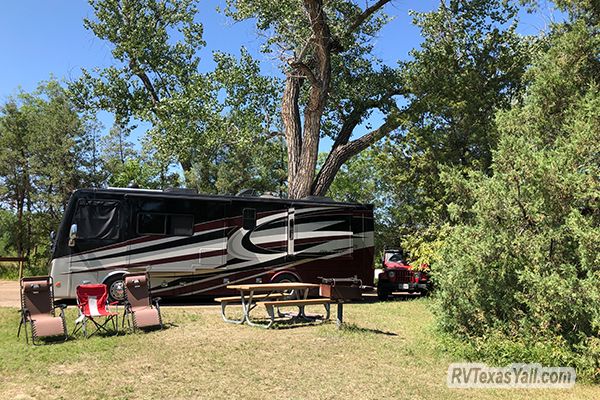

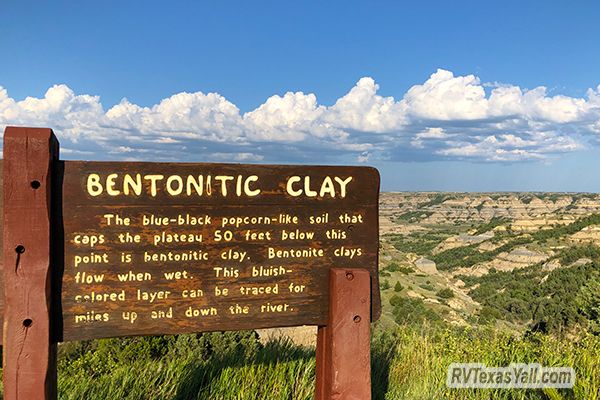
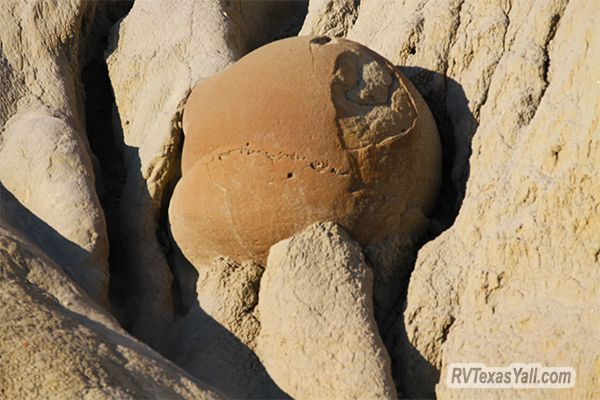
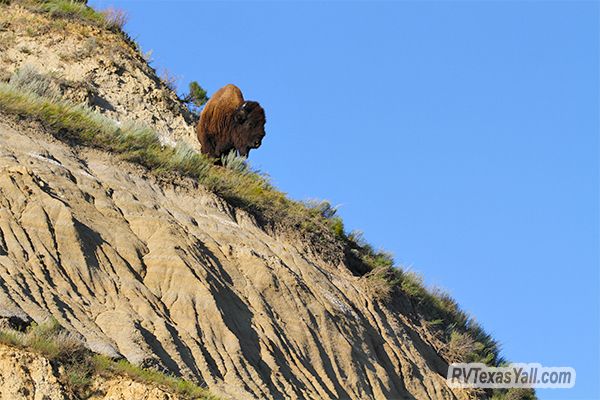
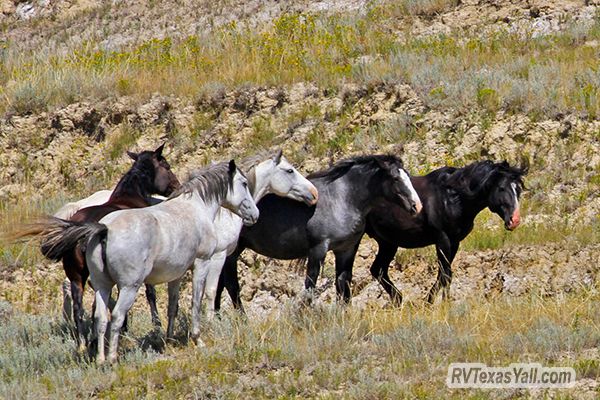
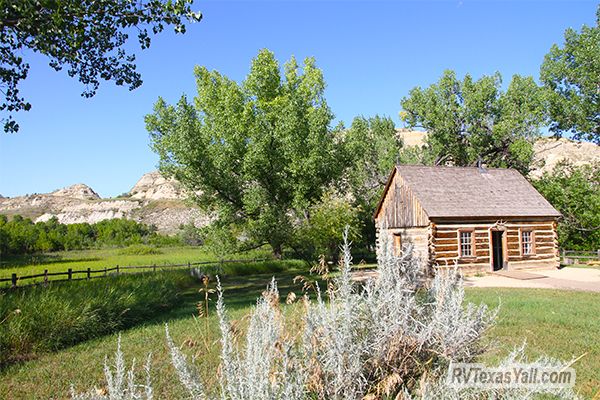
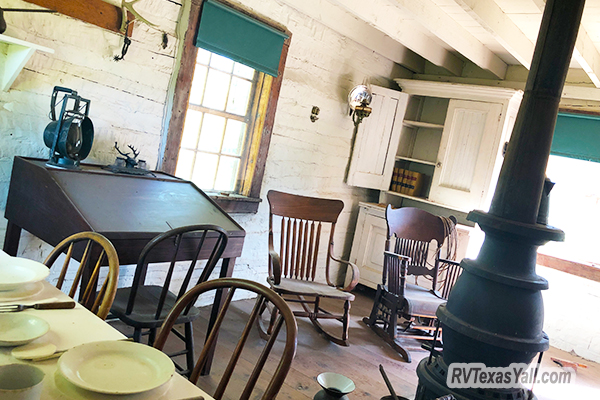
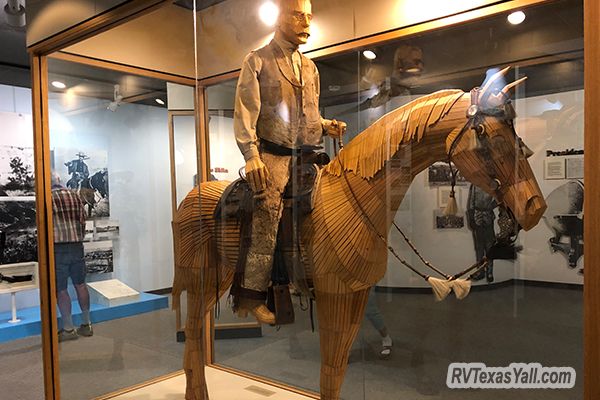
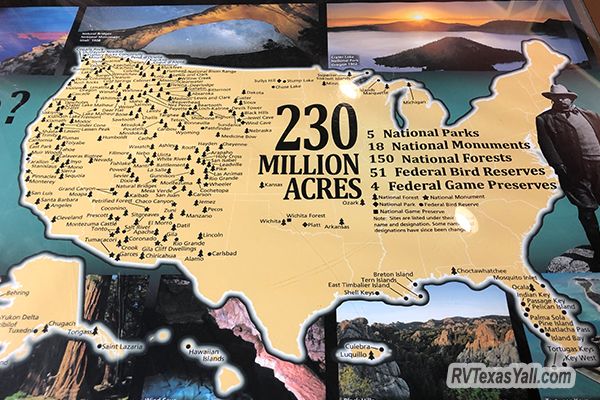
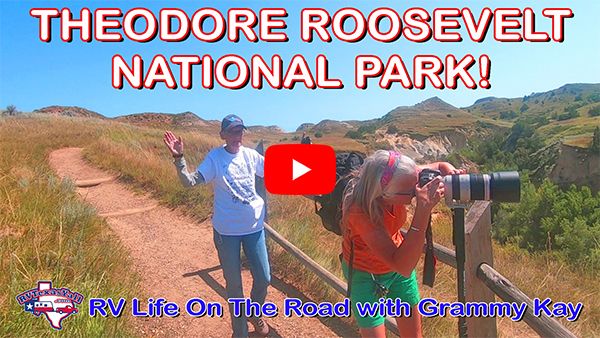
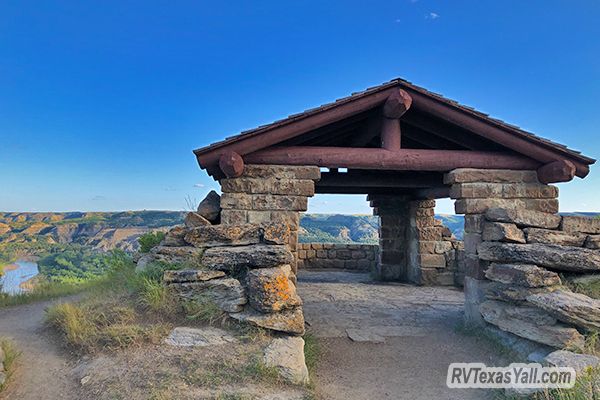

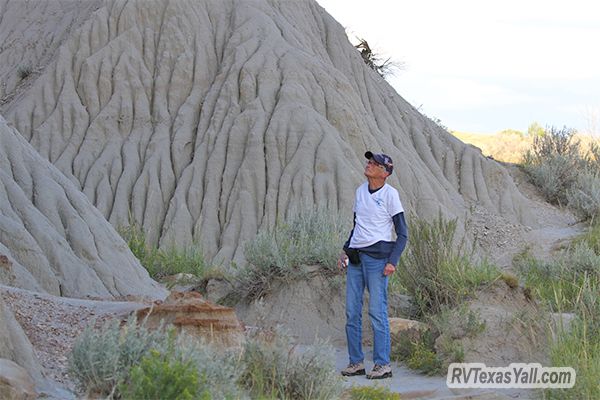
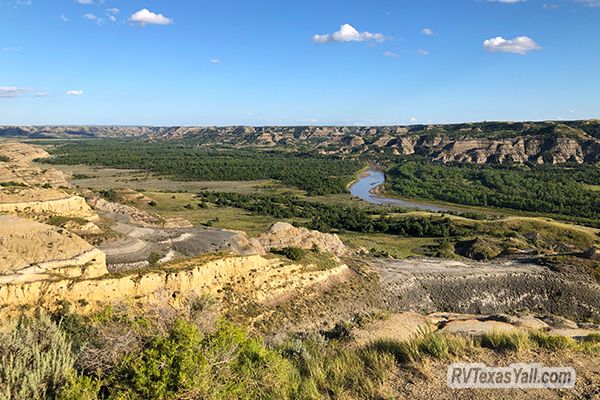
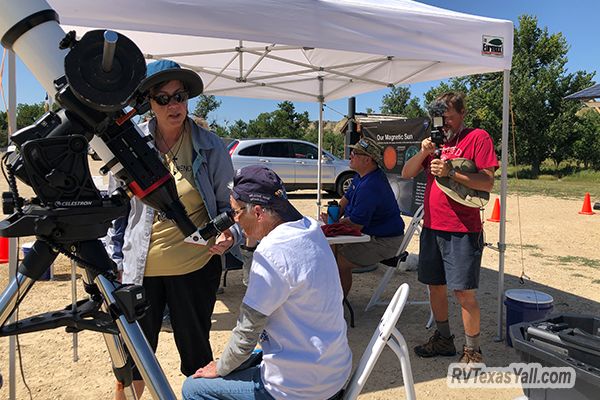
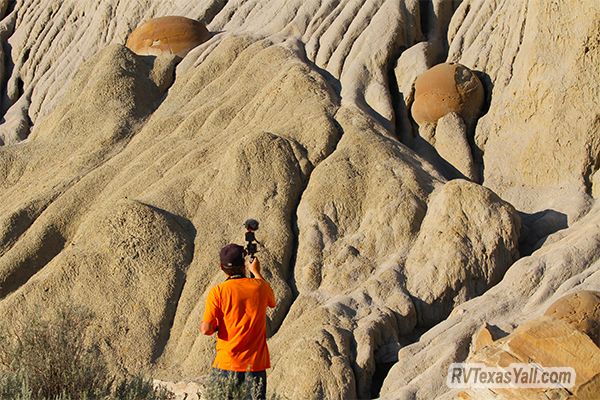
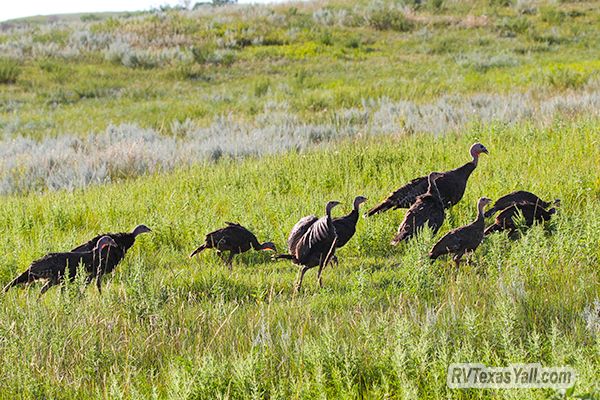
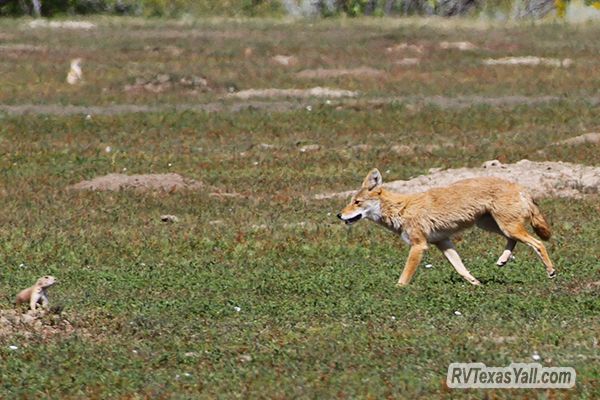
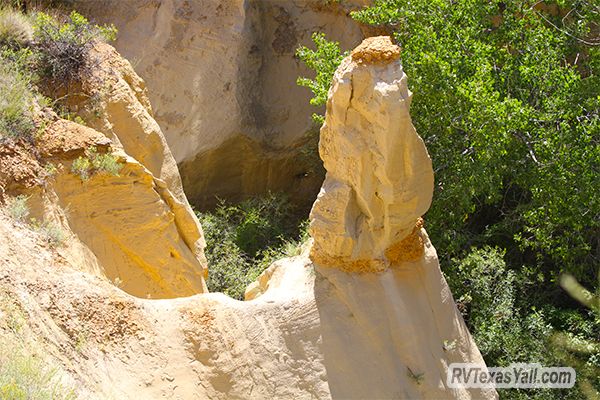

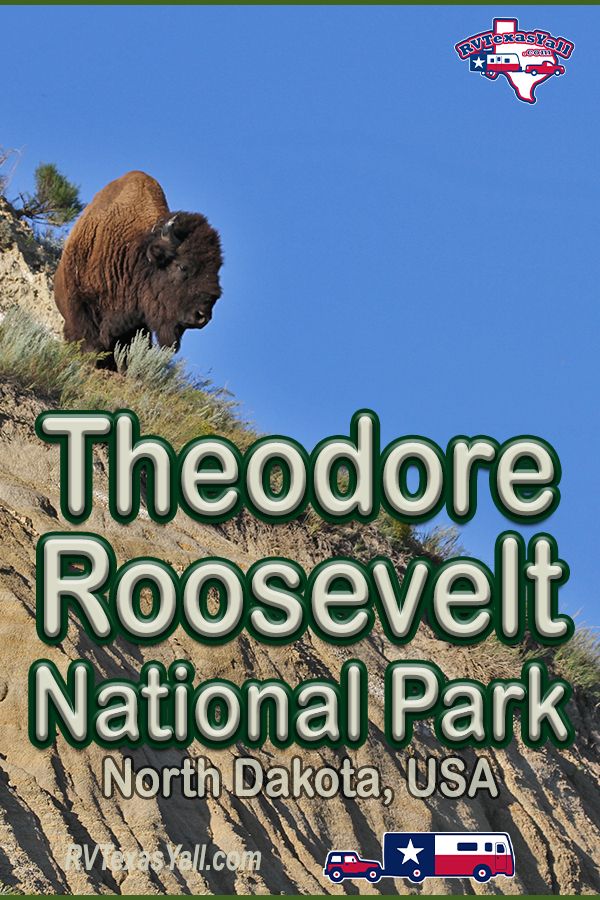
Share Your Thoughts:
We always love hearing about your travels and seeing pictures of your campsites, rigs and quirky, fun places you visit! Please join us in the RV in Texas Facebook Group or in the RV Texas Y'all Community on RVillage. Want more info? Learn more about our Facebook Group!
Safe Travels and Happy Camping!